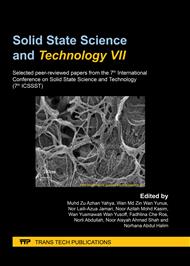[1]
A. Pei, N. Butchosa, L.A. Berglund, Q. Zhou, Surface quaternized cellulose nanofibrils with high water absorbency and adsorption capacity for anionic dyes, Soft Matter. 9 (2013) 2047-2055.
DOI: 10.1039/c2sm27344f
Google Scholar
[2]
M.N.F. Norrrahim, M.A.I.A. Razak, N.A.A. Shah, H. Kasim, W.Y.W. Yusoff, N.A. Halim, S.A.M. Nor, S.H. Jamal, K.K. Ong, W.M.Z.W. Yunus, V.F. Knight, N.A.M. Kasim, Recent developments on oximes to improve the blood brain penetration for the treatment of organophosphorus poisoning: a review, RSC Adv. 10 (2020) 4465-4489.
DOI: 10.1039/c9ra08599h
Google Scholar
[3]
M. Kliachyna, G. Santoni, V. Nussbaum, J. Renou, B. Sanson, J.P. Colletier, M. Arboléas, M. Loiodice, M. Weik, L. Jean, P.Y. Renard, Design, synthesis and biological evaluation of novel tetrahydroacridine pyridine-aldoxime and-amidoxime hybrids as efficient uncharged reactivators of nerve agent-inhibited human acetylcholinesterase, Eur. J. Med. Chem. 78 (2014) 455-467.
DOI: 10.1016/j.ejmech.2014.03.044
Google Scholar
[4]
W. Chigumira, P. Maposa, L.L. Gadaga, A. Dube, D. Tagwireyi, C.C. Maponga, Preparation and evaluation of pralidoxime-loaded PLGA nanoparticles as potential carriers of the drug across the blood brain barrier, J. Nanomater. (2015) 1-5.
DOI: 10.1155/2015/692672
Google Scholar
[5]
K.P.Y. Shak, Y.L. Pang, S.K. Mah, Nanocellulose: Recent advances and its prospects in environmental remediation, Beilstein J. Nanotechnol. 9 (2018) 2479-2498.
DOI: 10.3762/bjnano.9.232
Google Scholar
[6]
H. Voisin, L. Bergström, P. Liu, A. Mathew, Nanocellulose-based materials for water purification, Nanomaterials. 7 (2017) 1-19.
DOI: 10.3390/nano7030057
Google Scholar
[7]
W. Chen, H. Yu, Y. Liu, P. Chen, M. Zhang, Y. Hai, Individualization of cellulose nanofibers from wood using high-intensity ultrasonication combined with chemical pretreatments, Carbohydr. Polym. 83 (2011) 1804–1811.
DOI: 10.1016/j.carbpol.2010.10.040
Google Scholar
[8]
M.N.F. Norrrahim, H. Ariffin, T.A.T. Yasim-Anuar, M.A. Hassan, H. Nishida, T. Tsukegi, One-pot nanofibrillation of cellulose and nanocomposite production in a twin-screw extruder, IOP Conf. Ser. Mater. Sci. Eng. 368 (2018) 1-9.
DOI: 10.1088/1757-899x/368/1/012034
Google Scholar
[9]
R.A. Ilyas, S.M. Sapuan, R. Ibrahim, H. Abral, M.R. Ishak, E.S. Zainudin, M. Asrofi, M.S.N. Atikah, M.R.M. Huzaifah, A.M. Radzi, A.M.N. Azammi, M.A. Shaharuzaman, N.M. Nurazzi, E. Syafri, N.H. Sari, M.N.F. Norrrahim, R. Jumaidin, Sugar palm (Arenga pinnata (Wurmb.) Merr) cellulosic fibre hierarchy: a comprehensive approach from macro to nano scale, J. Mater. Res. Technol. 8 (2019) 2753-2766.
DOI: 10.1016/j.jmrt.2019.04.011
Google Scholar
[10]
H. Sehaqui, U.P. de Larraya, P. Tingaut, T. Zimmermann, Humic acid adsorption onto cationic cellulose nanofibers for bioinspired removal of copper (II) and a positively charged dye, Soft Matter. 11 (2015) 5294-5300.
DOI: 10.1039/c5sm00566c
Google Scholar
[11]
K.P.Y. Shak, Y.L. Pang, S.K. Mah, Nanocellulose: Recent advances and its prospects in environmental remediation. Beilstein J. Nanotechnol. 9 (2018) 2479-2498.
DOI: 10.3762/bjnano.9.232
Google Scholar
[12]
H. Bai, X. Wang, Y. Zhou, L. Zhang, Preparation and characterization of poly ( vinylidene fluoride ) composite membranes blended with nano-crystalline cellulose, Prog. Nat. Sci-Mater. 22 (2012) 250–257.
DOI: 10.1016/j.pnsc.2012.04.011
Google Scholar
[13]
H. Abral, V. Lawrensius, D. Handayani, E. Sugiarti, Preparation of nano-sized particles from bacterial cellulose using ultrasonication and their characterization, Carbohydr. Polym. 191 (2018) 161–167.
DOI: 10.1016/j.carbpol.2018.03.026
Google Scholar
[14]
L. Yuan, J. Wan, Y. Ma, Y. Wang, M. Huang, Y. Chen, The content of different hydrogen bond models and crystal structure of eucalyptus fibers during beating, Bioresources. 8 (2013) 717-734.
DOI: 10.15376/biores.8.1.717-734
Google Scholar


